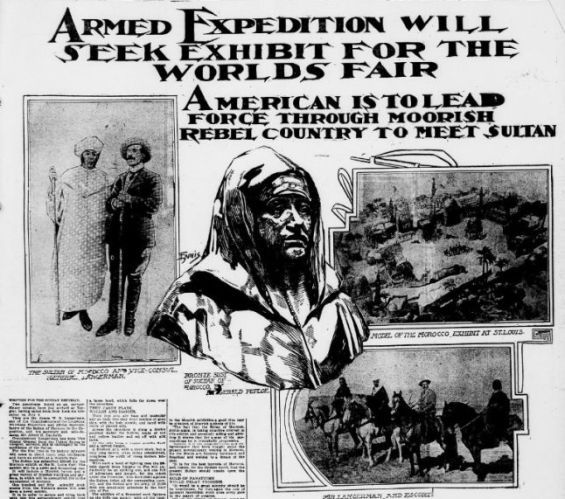While Morocco was in the midst of a fierce revolt led by a pretender to the throne, Sultan Abdelaziz planned a splendid exhibition for the upcoming World's Fair in St. Louis, Missouri. He intended to showcase Moroccan art and customs.
Sultan Abdelaziz pledged $200,000 for the Morocco exhibit, which would include a Moorish harem and a variety of Moorish buildings and gardens, according to a July 19, 1903, issue of The Republic. The exhibit also promised fifty splendid Arab steeds from the Sultan's stable.
The biggest challenge was transporting the exhibit from Morocco to the United States. Sailing across the Atlantic was the easy part. The real difficulty was navigating «through the rebel lines from Tangier to Fez, where the Sultan is under siege», and then securing the exhibit's journey to Tangier for its voyage to the United States.
A perilous journey to Fez
Two Americans were entrusted with this mission: Mr. James W. S. Langerman, a commissioner of the Louisiana Purchase Exposition and the Sultan's official representative, and his secretary and aide-de-camp, Mr. Albert H. Danforth.
Langerman, a trusted confidant of the Sultan, was appointed Vice Consul General from the United States to Tangier specifically for this extraordinary mission. Well-prepared for the risky passage, Langerman sailed from New York to Gibraltar and then on to Tangier.
On his way to Fez, Langerman and his delegation were accompanied by «one thousand hardy Riffs, from the wild Riffian tribes that inhabit the mountains». Their role was to «act as a bodyguard to the expedition» provided by Morocco.
In addition to the Moroccan-provided manpower, Langerman brought an arsenal for a safer passage, including «rifles, rapid-fire guns, and small cannon».

The American envoy didn't forget to bring gifts for the Sultan. Langerman presented a variety of ornamental items, including «a bust of that monarch cast in bronze, an album bound in red morocco containing portraits of the world's rulers, all sorts of modern inventions, such as photographs, and also a fast pacing horse and a mule».
«I have been told that it will be impossible for us to break through the rebel lines and reach Fez, but I intend to do it, and thus prove that it is feasible», Commissioner Langerman told The Republic before his march.
«I fully appreciate that the undertaking has its risks and dangers, but I have secured a large force of fighters and they will be much better armed than the rebel forces, many of whom carry nothing better than the old-time flintlock muskets, the only gun that the Moors even today know how to make».
The journey was expected to take 10 days, according to the American envoy, who hailed the Sultan's interest in the exhibition. «No other exhibition has ever been able to secure an exhibit from the Land of the Moor», he told the newspaper.
Going into more details, Langerman explained that the Moroccan exhibit would have a Moorish harem, accessible only to women visitors. «The women of our country will thus be able to contrast their lots with those of the secluded women of the harem», he promised. Additionally, the show would include Moroccan merchants «who will erect their curious little stalls, wherein will be displayed curious articles of Moroccan manufacture».
The Moroccan delegation also included cooks to prepare dishes for visitors in the Moroccan style.
«The fact that the Sultan of Morocco, Abdelaziz, is taking an active interest in this exhibit and personally aiding and abetting it shows that for a man of his surroundings he is remarkably progressive», the newspaper remarked.
The saddle and the letter
As a gesture of courtesy, Sultan Abdelaziz sent a gift in return for President Theodore Roosevelt. The Moroccan monarch presented Commissioner Langerman with a «gorgeous Moorish saddle with trappings of green, red, and gold» for President Roosevelt. The present was also accompanied by a letter from the Sultan, written in Arabic and beautifully inscribed.

The letter and saddle were presented to the president in Washington. While delighted with the saddle, President Roosevelt was unable to read the letter according to the same newspaper, as he couldn't find a translator in Washington.
The President said he «intended to make use of the saddle and when he does ride it he will create a sensation, for it is the most gorgeous saddle in the country». He further hailed relations with Morocco, insisting that the United States «is the only country in the world that has ever been able to establish such relations with a Sultan of Morocco that he would actually allow and support an exhibit at an exposition. This is a significant fact».





 chargement...
chargement...













